Using Sr isotopes to trace the geographic origins of Chinese mitten crabs
Hao-Ming Yin·Fang Huang,2·Jun Shen·Hui-Min Yu,2
Abstract Identifying the geographic origins of Chinese mitten crabs is important for food safety and fair market competition.In this study,we used strontium (Sr) isotopes as a tool to trace the geographic origins of Chinese mitten crabs.Chinese mitten crabs,water,and different types of crab feed were collected from four different lakes for Sr isotope analyses.The results showed that the Sr isotope compositions of the different parts from one single crab were consistent within error,indicating that any piece of a crab could be used to represent the Sr isotope characteristics of the whole crab.The Sr isotope compositions of Chinese mitten crabs from the same lake were consistent within the analytical error,and the values were similar to the Sr isotope composition of the water from the same lake.However,the Sr isotope compositions of water and crabs from different lakes are significantly different.Therefore,the Sr isotope compositions of Chinese mitten crabs are mainly controlled by lake water composition,while the impact of feed is limited.This study provides an effective method for tracing the geographic origins of Chinese mitten crabs.
Keywords Chinese mitten crab·Lakes·Sr isotopes·Geographic origin
1 Introduction
Chinese mitten crab is one of the high-quality goods in Chinese food markets.Chinese mitten crab is native to coastal rivers and estuaries,and this crab has become the most widely distributed crab species in Asia.Other distributions are found in Europe and North America (Fialho et al.2016).In China,the main culture areas of Chinese mitten crabs are distributed in the Yangtze,Yellow,and Liaohe Rivers.The largest aquaculture ponds are located in freshwater lakes in the middle and lower reaches of the Yangtze River(Zhang et al.2018).This crab species tastes delicious and is rich in nutrients,and for these reasons,Chinese mitten crab is an important product in Chinese aquatic market (Chen et al.2007).However,in today’s market,high-quality Chinese mitten crabs are often replaced by inferior products for economic benefits,and as a result,the rights of consumers and producers are severely damaged.For example,the actual output of Yangcheng Lake crabs,which is a famous geographical indication product,accounts for only a small fraction of market sales(Zhao 2014).In 2005,the Chinese government issued‘‘Regulations on the Protection of Geographical Indication Products’’ to protect regional agricultural development.Chinese mitten crab is on the list of protected species.Therefore,to protect the rights of consumers and producers and maintain normal market order,it is critical to developing an effective analytical technique to help track the geographic origins of Chinese mitten crabs.
The traditional methods for tracing the origins of Chinese mitten crabs include morphological techniques(Wang et al.2007),elemental ‘‘fingerprints’’ (Zhao et al.2014),DNA ‘fingerprints’’ (Zhang et al.2018),and physicochemical properties (Gu et al.2014).However,in some cases,the sensitivities of these methods are not ideal(Zhao.2014).A new technique with higher precision and accuracy is needed.Isotopes might be a useful tool for tracing the origins of Chinese mitten crabs.Luo et al.(2019) tried to constrain the geographic origins of Chinese mitten crabs from different habitats using C and N isotopes,combined with trace element data.However,because both C and N are major elements in organisms and the mass numbers of C and N are low,C and N isotopes can be significantly fractionated in the metabolic processes of organisms(Camin et al.2016).Therefore,the C and N isotope compositions of crabs do not only represent the signatures of their natural geographical environments but also could be affected by other processes.A more effective method is necessary for tracing the geographic origins of Chinese mitten crabs.
Strontium (Sr) is an alkaline earth element.There are four stable Sr isotopes in nature,88Sr,87Sr,86Sr,and84Sr,with abundances of 82.5845,7.0015,9.8566,and 0.5574%,respectively.87Sr is formed through the radiogenic decay of87Rb(Meija et al.2016),with a decay half-life of 49 Ga(Faure 1986).The radiogenic Sr isotope ratio is expressed by87Sr/86Sr.Rb and Sr are typical dispersing elements that rarely form independent minerals.The ionic radius of Sr(0.113 nm) is similar to that of Ca (0.099 nm),and the ionic radius of Rb (0.147 nm) is similar to that of K(0.133 nm).Therefore,Rb and Sr are often present in minerals containing potassium and calcium in isomorphism,respectively (Guo et al.2007).Different minerals have different enrichment abilities for Rb and Sr,leading to distinct87Sr/86Sr ratios in different geological environments over time.Strontium is an important life-related element that is mainly absorbed from soil,water,and food by animals and plants (Kelly et al.2005).The Sr isotope signature of soil is inherited from its parent rock,while the Sr isotope signature of water mainly depends on the composition of dissolved minerals in the water.Different soils and water with different properties generally have inconsistent87Sr/86Sr ratios.Therefore,plants or animals from different areas might have different Sr isotope compositions because the87Sr/86Sr ratios of organisms depend on local geological conditions (Dasch 1969; Graustein 1989;Hurst and Davis 1981).Previous studies have shown that the Sr isotope compositions of plants and animals have good correlations with the Sr isotope compositions of their origins (Fortunato et al.2004).Therefore,an increasing number of researchers have used Sr isotopes to track the origins of different foods (Capo et al.1998; Ghidini et al.2006),such as the origins of wine(Horn et al.1993),coffee beans (Techer et al.2011),tea (Pilgrim et al.2010; Lagad et al.2013),mineral water (Montgomery et al.2006),fruit juice (García-Ruiz et al.2007),and rice (Kawasaki et al.2002).Therefore,we attempted to use Sr isotopes to trace the origins of Chinese mitten crabs in this study.
2 Sample collection and analytical methods
2.1 Sample collection
The Chinese mitten crabs analyzed in this study were collected from three lake habitats and an aquaculture pond located in the lower reaches of the Yangtze River,China:Taihu Lake,Gucheng Lake,Yangcheng Lake and a pond in the Xinghua area.The geographic locations of these sites are shown in Fig.1.The samples from Yangcheng Lake were collected in different seasons (September and December) to assess whether different seasons or environmental temperatures andgrowth periods affect the Sr isotope compositions of the crabs.Lake water samples were also collected at the same time as the crab samples from the corresponding areas.To assess the homogeneity of Sr isotopes in the lake water,separate water samples from Yangcheng Lake were collected from the lake margin to the lake center (five locations).In addition,different types of feed samples from Yangcheng Lake and Gucheng Lake were collected to constrain the effect of crab food.All sample information is summarized in Table 1.
2.2 Sample digestion and chemical purification
The crab and feed samples were rinsed with Milli-Q water,and the crabs were then separated into different parts(crab shell,pereiopod,and crab claw).All of these samples were frozen at -20 °C for 24 h and then dried using a vacuum freeze dryer for 24 h at 0.05 atm.The dried samples were ground into powder using an agate mortar and pestle.The water samples were evaporated to dryness on a hotplate.
The chemical purification procedures for all samples were performed in the clean laboratory of the CAS Key Laboratory of Crust-Mantle and Environments at the University of Science and Technology of China (USTC),Hefei.The concentrated hydrochloric acid(HCl,10.8 mol/L) and nitric acid (HNO3,15.3 mol/L) used in the chemical process were both purified by double distillation.All reagents were then diluted from concentrated acids with ultrapure water (18.2 MΩ cm) obtained from a Milli-Q system.Hydrogen peroxide (30% v/v,ultrapure,AUECC)was also used during the experiment.
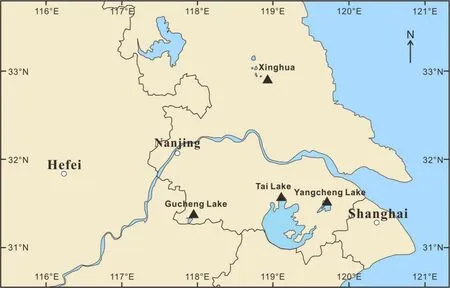
Fig.1 Geological map of the middle and lower reaches of the Yangtze River.The sample collection locations of the Chinese mitten crabs were (1)Xinghua; (2) Yangcheng Lake;(3)Gucheng Lake;and(4)Taihu Lake

Table 1 Description of the sampling plan
Approximately10 mg of sample powder (crab parts or feed)was digested for the Sr concentration and isotope analyses.The sample powder was digested with 1 mL of 1 mol/L HCl at 120 °C for 12 h to remove carbonates,and a 3:1 (v/v) mixture of H2O2(30% v/v) and HNO3(15.3 mol/L)to remove organic materials.The residual insoluble parts of the samples were digested with an aqua regia (a 3:1 (v/v) mixture of HCl (10.8 mol/L) and HNO3(15.3 mol/L)) and heated on a hotplate at 100 °C until the solution was completely clear.The samples were then evaporated to dryness at 100 °C and dissolved in 2 mL of 3 mol/L HNO3.One milliliter of the sample solution was diluted to 100 mL for the Sr concentration measurement,and the remaining 1 mL of the sample solution was used for the Sr isotope analyses.
The filtered lake water samples were dried and treated with a 3:1 (v/v) mixture of H2O2(30% v/v) and HNO3(15.3 mol/L)to remove organic materials.Then,the lake water samples were redissolved in 2 mL of 3 mol/L HNO3,and the same procedure that was performed on the crab and feed samples was conducted.
The Sr purification procedure was modified from the method of Philip et al.(1992),and the details of the procedure are listed in Fig.2.Strontium (~5 μg) was purified using 0.1 mL of Sr-special resin (SR-B200-A,100–150 μm,Triskem International,France).After the samples were loaded in 1 mL of 3 mol/L HNO3and the matrix elements were eluted with 2 mL of 3 mol/L HNO3,Sr was collected with 1.5 mL of ultra-pure water.The Sr recoveries were >70 %.Theprocedural blank was less than 0.5 ng,which was negligible compared to the 5 μg of Sr loading on the column.
2.3 Instrumental analyses
The Sr concentration was determined by inductively coupled plasma mass spectrometer (ICP-MS) in the same laboratory.The parameters of the instrument settings are shown in Table S1.Rh was used as an internal standard to correct instrumental drift (Jenner et al.1990).
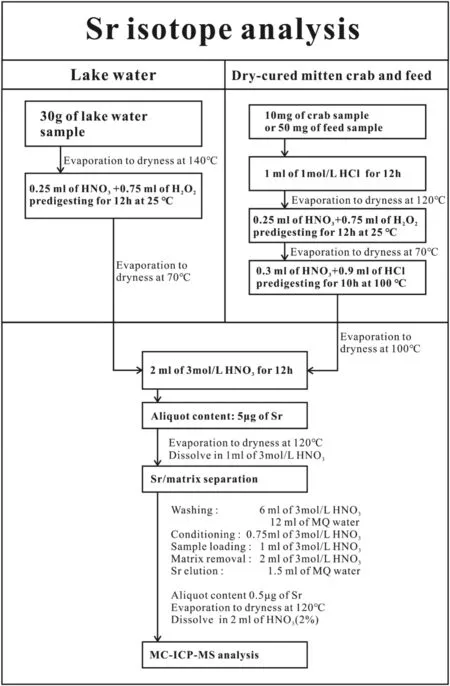
Fig.2 Flowchart of the Sr isotope analysis procedures
The Sr isotope measurements were performed with a multi-collector inductively coupled plasma mass spectrometer (MC-ICP-MS) (Neptune Plus,Thermo-Fisher Scientific,USA) in the same laboratory.82Kr,83Kr,84Sr,85Rb,86Sr,87Sr,and88Sr were collected by Faraday cups of L4,L3,L2,L1,C,H1,and H2,respectively.The isobaric interference effect of87Rb to87Sr was corrected using the signal of85Rb.A quartz dual cyclonic spray chamber(ESI),a PFA microflow nebulizer(ESI)with an uptake rate of~50 μL/min,and nickel cones (H skimmer and Jet sampler cones,Thermo-Fisher Scientific) were used for sample introduction.The sensitivity of88Sr was~100 V/(μg/g),with low mass resolution.
The mass bias produced by the instrument was corrected by setting the86Sr/88Sr ratio as a constant number,0.1194.The precision and accuracy of the Sr isotope measurement were monitored using the NIST SRM 987 reference material(Waight et al.2002).The precision of87Sr/86Sr in the laboratory was better than ± 0.000018(2SD,n=528),based on the long-term measurements of NIST SRM987.The precision of Sr isotope analysis in this study is better than the long-term precision,so we use ± 0.000018 to represent the precision of Sr isotope analysis in this manuscript.The Sr isotopes of two rock standards from the US Geological Survey (USGS) (BCR-2 and BHVO-2)were analyzed with the samples to monitor the precision and accuracy of the Sr isotope analyses.Their87Sr/86Sr ratios agreed with reported data within the uncertainty range(Raczek et al.2003),indicating that the precision and accuracy of the Sr isotope measurements in this study were reliable (Table 2).
2.4 Statistical analysis
Data processing and statistical analyses were performed with SPSS 21.0.Classical linear regression analysis was used to model the relationship of the87Sr/86Sr isotopic value for water (y) and crabs (x).The nonparametricKruskal–Wallis testwas employed to evaluate differences in the mean87Sr/86Sr ratios between the crabs collected from different sites.In this analysis,a probability level of p <0.05 is considered statistically significant.
3 Results and discussion
3.1 Variations in the Sr concentrations and isotope characteristics within Chinese mitten crabs
The Sr concentrations (dry weight basis) of different parts of the same Chinese mitten crabs and different Chinese mitten crabs from the same and different lakes were analyzed.The data showed that there were large Sr concentration variations in different parts of the same crab and different crabs from the same and different lakes (Table 2 and Fig.3).The average Sr concentrations of crabs from different sampling locations varied from 653 to 1004 mg/kg,which were slightly different but overlapped within a certain range.As mentioned previously,the main source of Sr in the crabs is the surrounding environment; hence,differences in the Sr concentrations in the crabs might reflect different growth environments.However,crabs from the same lake also showed large variations in their Sr concentrations,which might reflect the different ability of each crab to enrich Sr.Therefore,using Sr concentrations to constrain the geographic origins of crabs is not reliable.
Strontium isotopes might provide more information for tracking the origins of Chinese mitten crabs.To evaluate whether the Sr isotope compositions of the same Chinese mitten crab (e.g.,crab shell,pereiopod,and crab claw)were spatially homogeneous,we analyzed the Sr isotope compositions of the crab shell,the right third pereiopod,the right fourth pereiopod,the left fourth pereiopod,and thecrab claw from the same single crab.The results showed that the Sr concentrations of different parts of the same crab were different,varying from 583 μg/g to 734 μg/g(Fig.3).However,the87Sr/86Sr ratios of different crab parts varied from 0.710719 to 0.710734,which were consistent within the analytical error allowance (Fig.3).This finding demonstrates that different parts of Chinese mitten crab have homogeneous Sr isotope compositions,and any part of the crab can represent the Sr isotope composition of the whole crab.
The87Sr/86Sr ratios of the crab,feed,and lake water samples from different sampling locations are reported in Table 2,while the results of the Kruskal–Wallis test are reported in Table S2 in electronic supplementary material.The87Sr/86Sr ratios of the crabs varied from 0.710378 to 0.710987,and crabs from different lakes had different variation ranges of Sr isotopes (Fig.4.).The single crab collected from Taihu Lake had the lowest87Sr/86Sr ratio(0.710378) among all crabs.The87Sr/86Sr variation of crabs from Xinghua pond was 0.710484–0.710570,from Yangcheng Lake was 0.710688–0.710718,and from Gucheng Lake was 0.710850–0.710987.The mean87Sr/86Sr ratios of the water and crab samples from different lakes were significantly different (Fig.4).Yangcheng Lake is the most famous aquaculture area in China,and its crabs have long been the target of crab adulteration(Luo et al.2019).Therefore,the crabs from Yangcheng Lake were the main targets for tracing geographic origin.The samples from Yangcheng Lake collected in two different seasons (September and December) had similar Sr isotope compositions.The mean87Sr/86Sr ratio of crabs collected inSeptember was 0.710522 ± 0.000020(n=23),while the mean87Sr/86Sr ratio of crabs collected in December was 0.710529 ± 0.000041 (n=20).These two mean values were consistent within the analytical error allowance,indicating that the influences of season and growth progress on the Sr isotopes of crabs were negligible.The mean87Sr/86Sr ratio of the crabs in Gucheng Lake was 0.710909 ± 0.000087(n=10),which was the highest87Sr/86Sr ratio found in the several lakes.Slight differences existed for these individuals from Gucheng Lake that may be related to (1)irregularities or defects in the mineralization process (Tzeng et al.2007);or (2)accidental physical irregularities,in particular in crab shell sexposed externally(Pouilly et al.2014).However,Gucheng Lake was still clearly separated from the other lakes.The mean87Sr/86Sr ratio of the Xinghua pond crabs was 0.710698 ± 0.000043(n=3),which was between the values for those in Yangcheng Lake and Gucheng Lake.
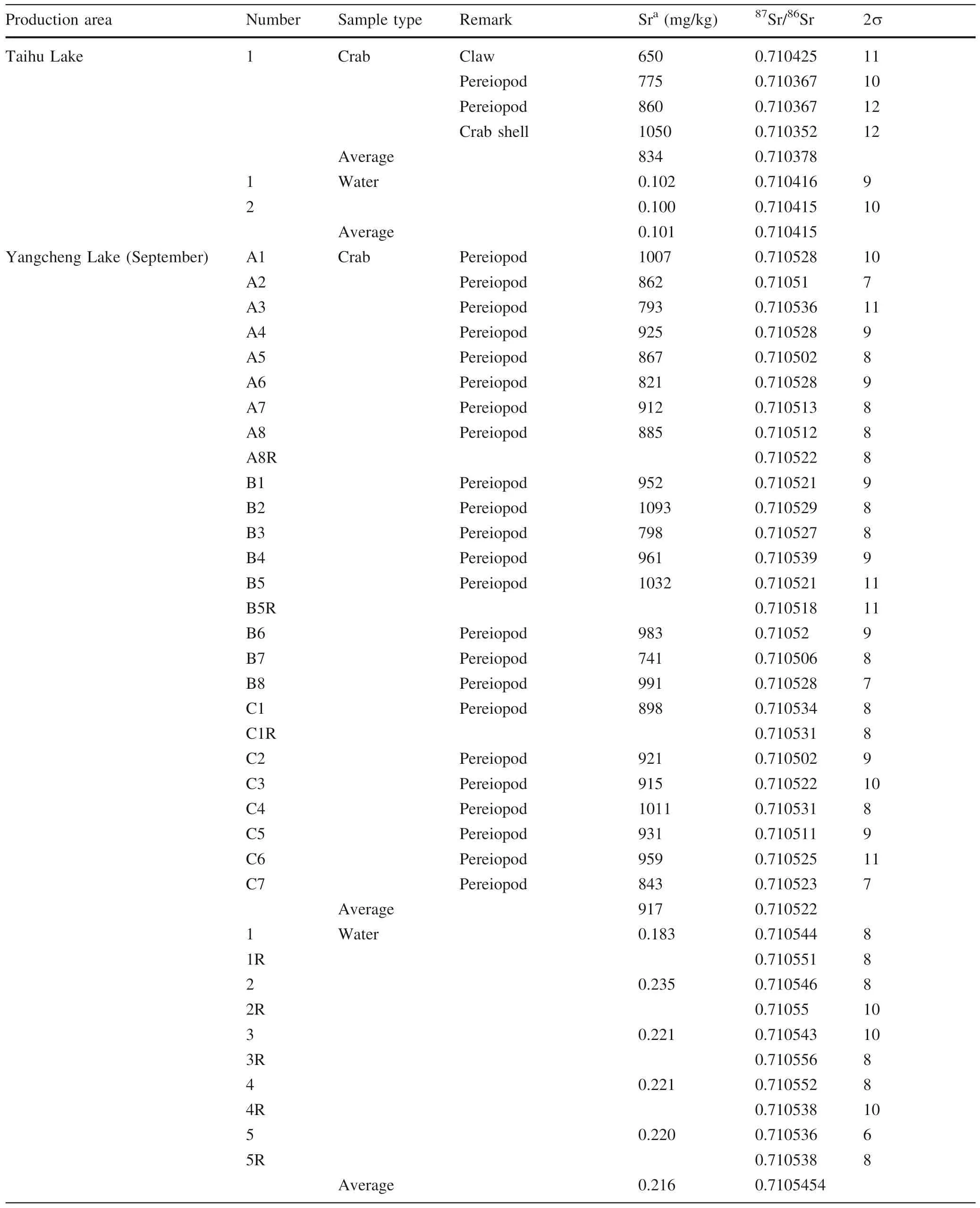
Table 2 Strontium isotope data for the Chinese mitten crab,lake water,and feed samples
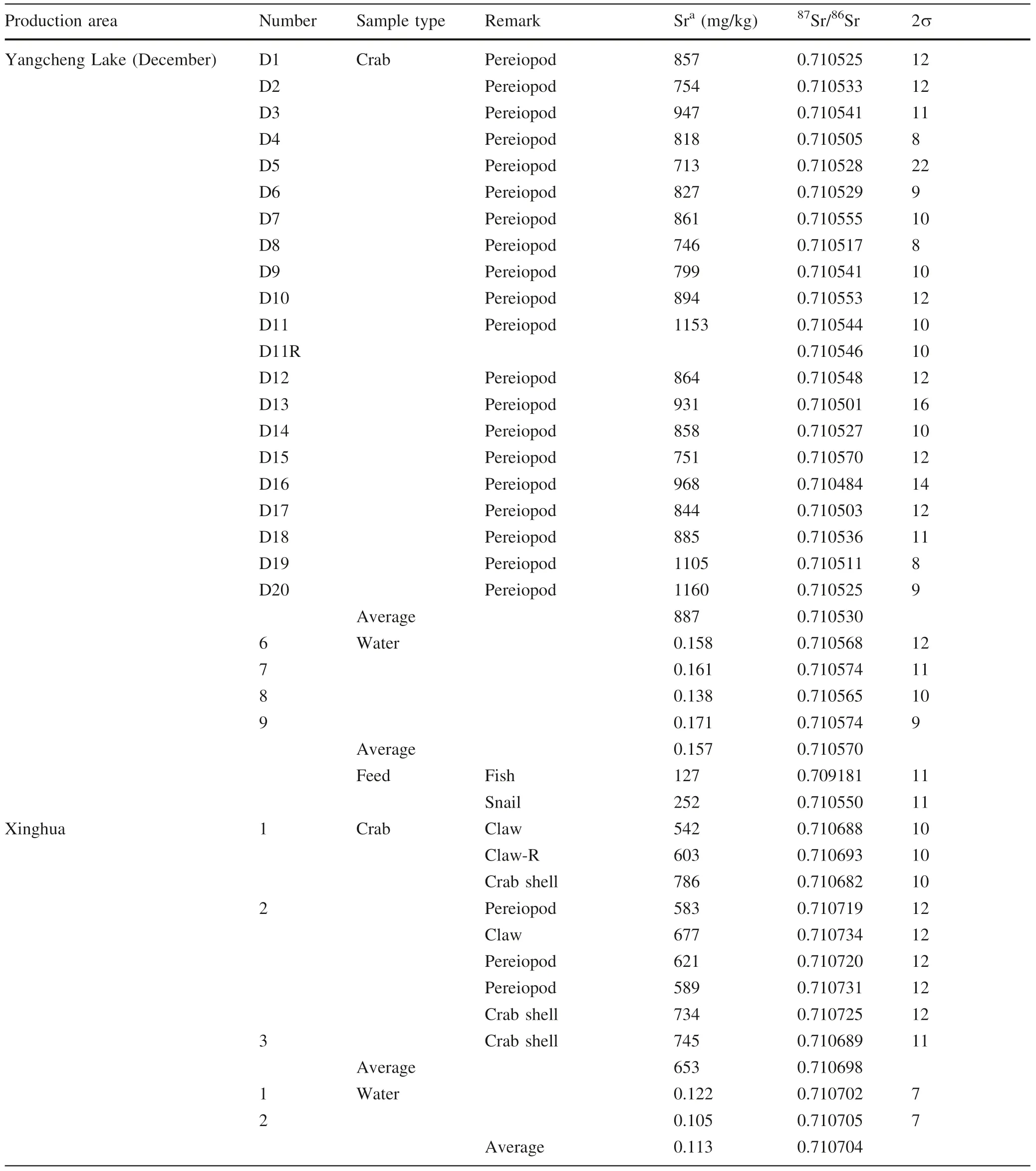
Table 2 continued
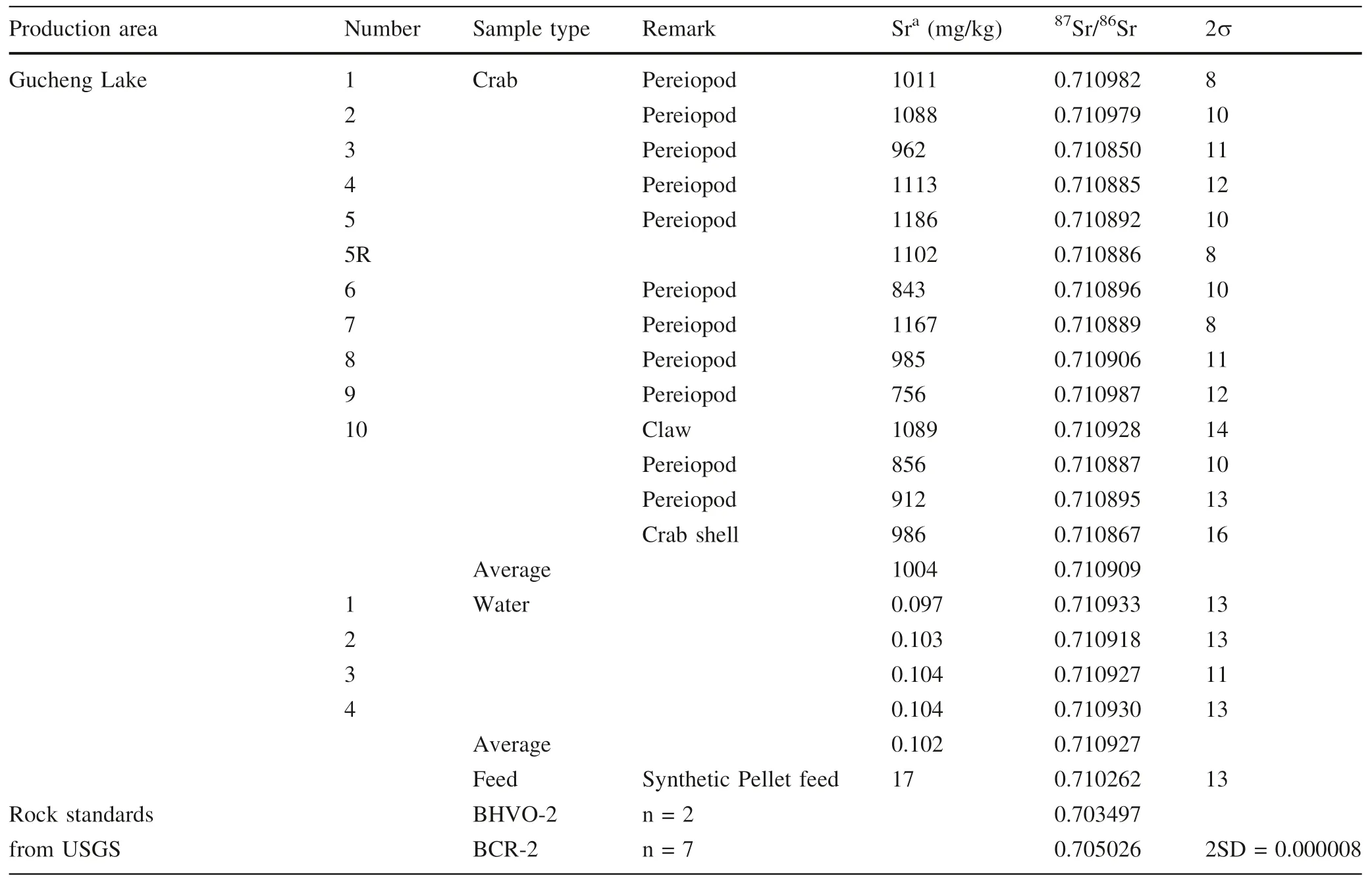
Table 2 continued
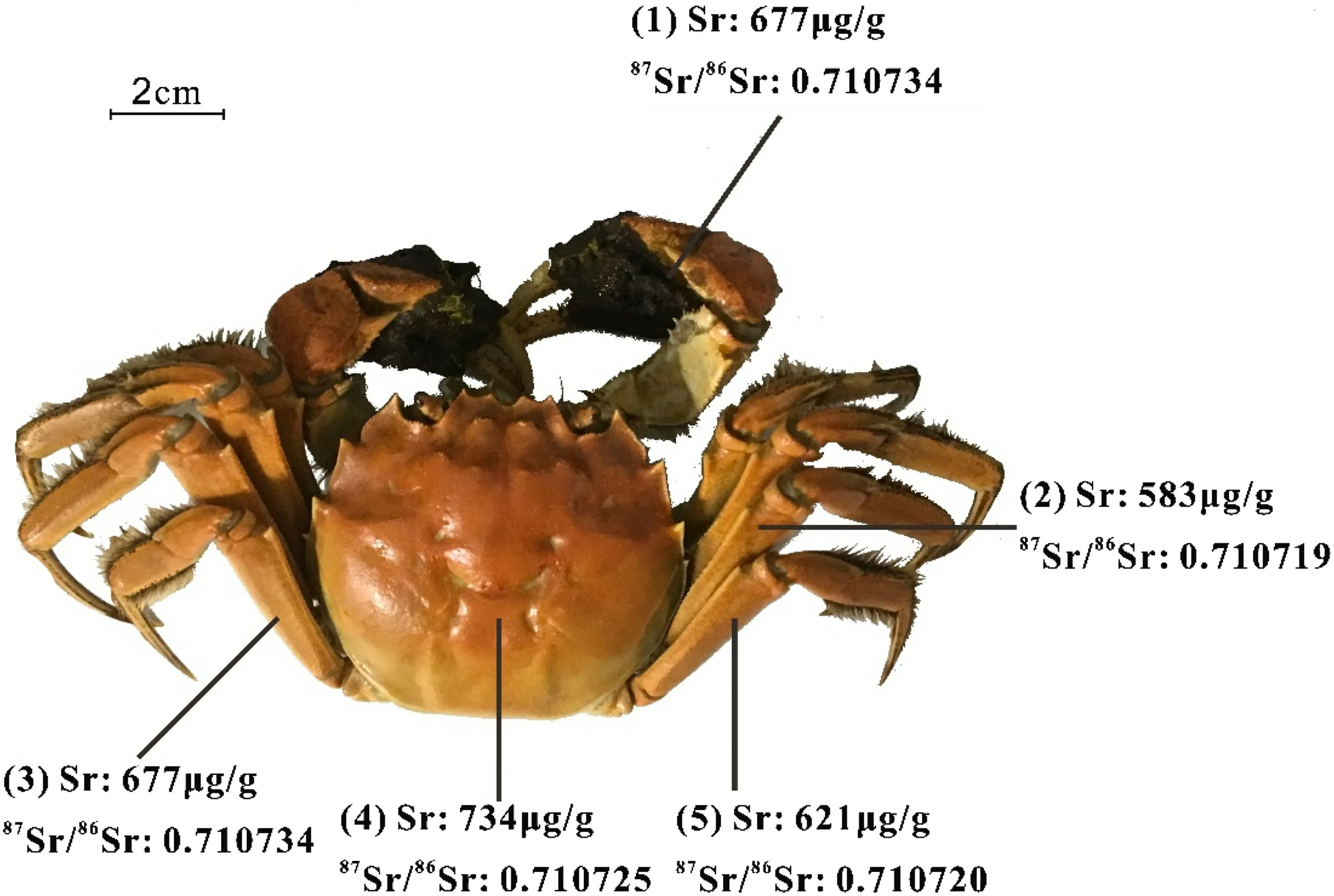
Fig.3 Schematic diagram of the Sr concentrations and isotope ratios in different parts of one crab:(1) claw; (2) right third pereiopod; (3) left fourth pereiopod; (4) crab shell; and(5) right fourth pereiopod
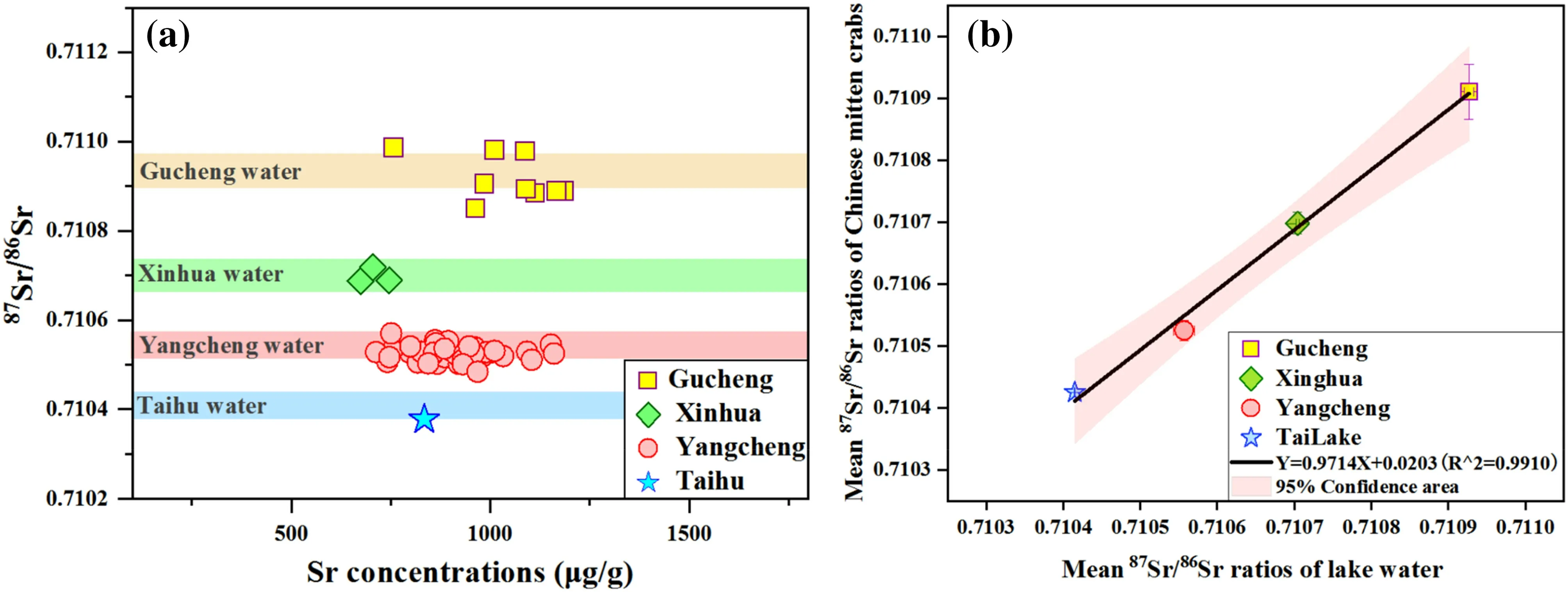
Fig.4 a The Sr isotope compositions of Chinese mitten crabs and lake water samples from different lakes.b The mean 87Sr/86Sr ratios of lake water and Chinese mitten crabs from different lakes
3.2 The Sr isotopes of Chinese mitten crabs from different geographic origins
Previous studies found that the source of Ca in the shells of crabs is mainly from the surrounding seawater (Hegdahl et al.1978).Because the properties of Sr are similar to those of Ca,it has been speculated that the Sr in shells is mainly derived from water as well.Walther et al.(2006)also found that the Sr in marine fish otoliths was mainly derived from water.In this study,we analyzed the Sr isotopes of lake water to determine whether the composition of water mainly controls the Sr isotopes in crabs.The87Sr/86Sr ratios of the lake water samples are listed in Table 2.The mean87Sr/86Sr ratios of the water samples from Taihu,Xinghua,Gucheng,and Yangcheng (September and December)Lakes(pond)were 0.710415,0.710704,0.710927,0.710545 (September),and 0.710570 (December),respectively.The water samples from Yangcheng Lake were collected from the lake margin to the lake center,and all samples showed very limited87Sr/86Sr variation.Therefore,the Sr isotope compositions of lake water samples can be used to represent the entire lake.The water samples collected from the same lake (Yangcheng Lake) had consistent Sr isotopes even though they were collected separately in different seasons.Therefore,the seasonal impact on the Sr isotope composition of lake water is limited.The difference in the Sr isotope compositions of different lakes was much larger than the analytical error,and the Sr isotope characteristics of different lakes could be clearly distinguished.These different Sr isotope signatures might be from the different dissolved materials supplied from different sources.As we discussed before,the Sr isotope signature of water mainly depends on the composition of dissolved materials in the water.Soil and surrounding rocks which weathered by the flowing river provides dissolved materials.For example,the surrounding rocks of Tai Lake are mainly sedimentary rocks,and of Yangcheng Lake are mainly intermediate or felsic igneous rocks (Zong 2014).These rocks have different Sr isotope signatures (Palmer et al.1992).So the lakes supplied by river flowed from these areas would have different Sr isotope compositions.
There is a positive correlation between the mean87Sr/86Sr ratio of Chinese mitten crabs and lake water(Fig.4):
87Sr/86Srcrab=0.9714*87Sr/86Srwater+0.0203,with r2equal to 0.991 and slope values statistically significant(p <0.01).
The mean Sr isotope compositions of crabs and lake water from the same area were consistent,indicating that the Sr isotopes of crabs could represent the Sr isotopes of lake waters.The positive correlation between the crabs and the lake water from different lakes also indicated that the Sr isotope composition of Chinese mitten crabs is controlled by the composition of lake water,and no isotopic fractionation occurs when crabs absorb Sr from lake water.This process is different from the stable isotopes of H,C,N and O,which are dramatically fractionated in the biological environment at low temperatures (Tommasini et al.2018).
In addition to the effects of water,the effects of other sources (such as feed) on the Sr isotopes of crabs should also be evaluated.In this study,we measured the Sr isotopes of three types of feed samples from two major lake areas(Table 2),including marine fish,snails,and synthetic pellet feed.The mean87Sr/86Sr isotope ratios of marine fish,Yangcheng Lake snails,and synthetic pellet feed were 0.709181,0.710550,and 0.710262,respectively (Table 2).The marine fish feed was derived from the ocean,and its Sr isotope composition was similar to the mean87Sr/86Sr ratio of modern seawater (87Sr/86Sr=0.709176) (Denison et al.1994).The87Sr/86Sr ratio of Yangcheng Lake snails was similar to that of local lake water (87Sr/86Sr=0.710557).The raw materials of the synthetic pellet feed were not from local lakes,so it is not surprising that its Sr isotopes were different from those of Gucheng Lake water.Except for the Yangcheng Lake snails,whose Sr isotopic values were also controlled by Yangcheng Lake water,the other feeds had Sr isotope values that were completely inconsistent with those of the crabs and lake water.This finding indicated that the Sr contribution of feeds to crabs is limited.In China,during the breeding process,most of the food for crabs is from local lakes,and farms only provide limited exogenous foods (such as fish,shellfish,and pellet feed) for economic reasons (Luo et al.2019).Therefore,the Sr isotope values of crabs are similar to those of the local water and feed on the same water,and the effect of exogenous feed on the crabs is negligible.Therefore,the Sr isotopes in crabs can be used to trace their geographic origins.
4 Conclusions
Different lakes have different Sr isotope compositions.The Sr isotope compositions of the crabs(shell and pereiopods)collected from the same lake had consistent Sr isotope compositions that were similar to those of the lake water where they were collected.But the Sr isotopes of the crabs were obviously different from those of exogenous feeds,indicating that feeds were not the main source of Sr to crabs.Lake water controls the Sr isotopes in crabs.Based on the current results,the Sr isotope method is a reliable tool for tracking the geographic origins of Chinese mitten crabs.
AcknowledgementsThis work was financially supported by the National Key Research and Development Program of China,the project of‘Source Identification and Contamination Characteristics of Heavy Metals in Agricultural Land and Products(2016YFD0800300),and by Natural Science Foundation of China (41721002).We gratefully thank Junxing Chen,Ruixia Bai,Jiayang Sun,Xuqi Chen,Nan Sun,and Yifan Li for help in sample preparation.
- Acta Geochimica的其它文章
- Even-carbon predominance of Monomethyl branched alkanes in Humic coal from Junggar Basin,NW China
- Hyperspectral estimation model of soil Pb content and its applicability in different soil types
- Geochemical constraints on the origin and tectonic setting of the serpentinized peridotites from the Paleoproterozoic Nyong series,Eseka area,SW Cameroon
- Zircon saturation model in silicate melts:a review and update
- Trace elemental signatures and mineral chemistry of clays associated with the alteration halos of the Paleoproterozoic U mineralization in Bijawars of the Sonrai Basin,Central India
- A re-assessment of nickel-doping method in iron isotope analysis on rock samples using multi-collector inductively coupled plasma mass spectrometry

